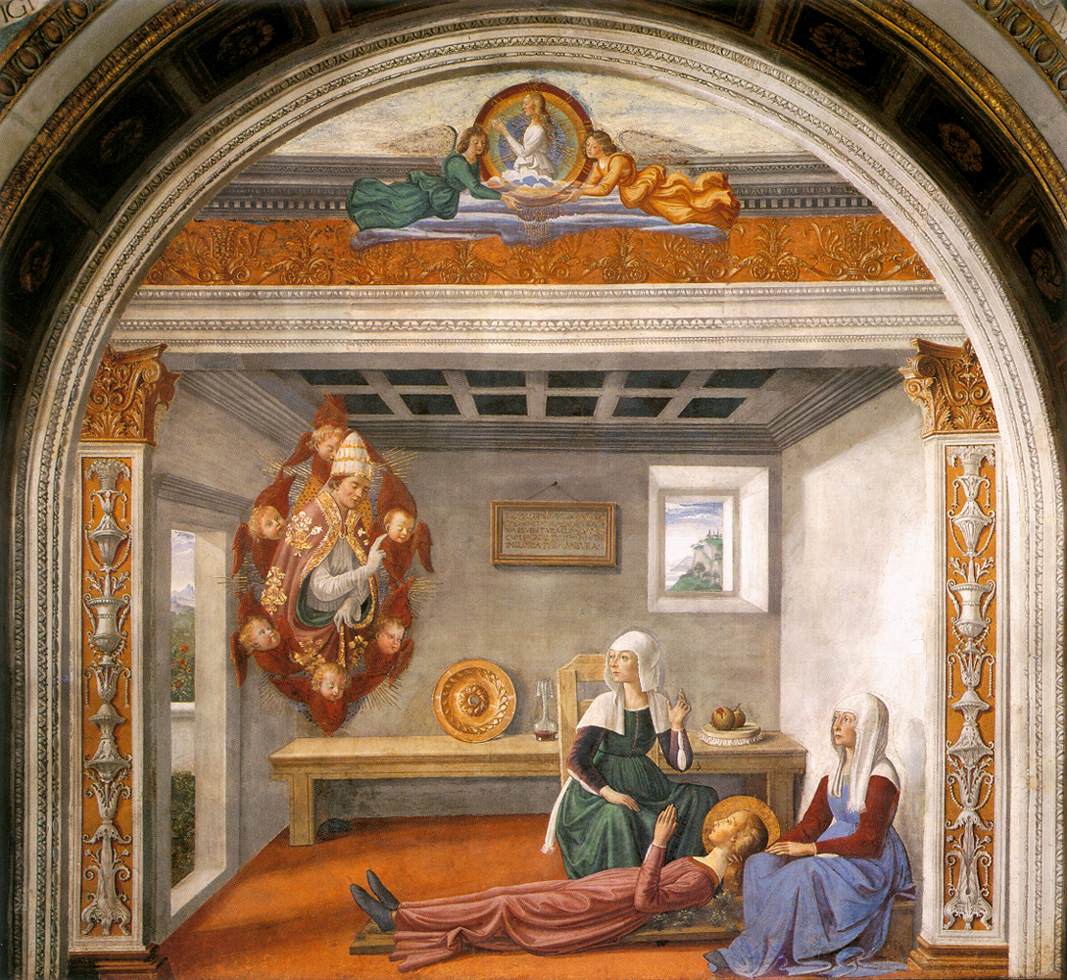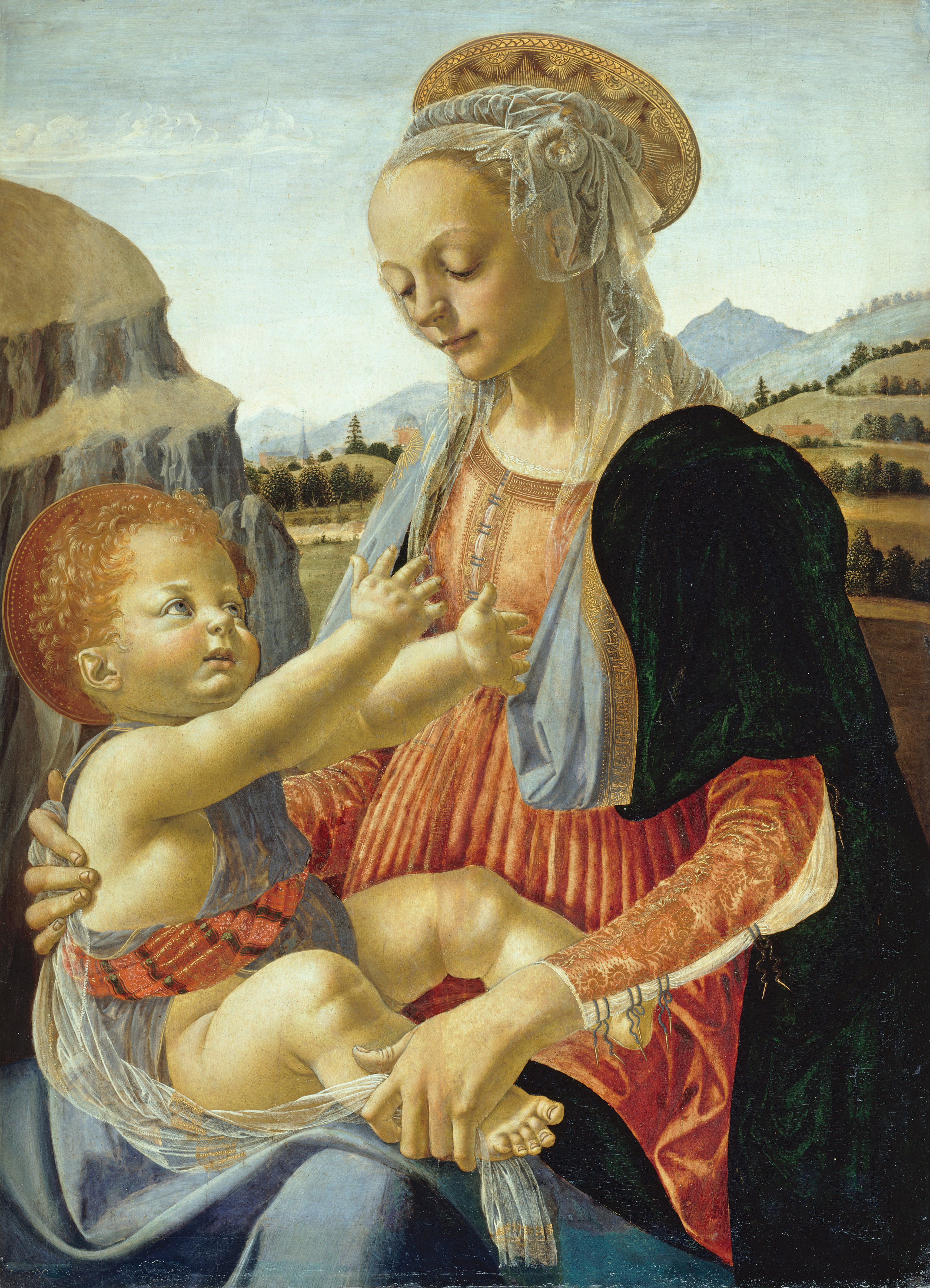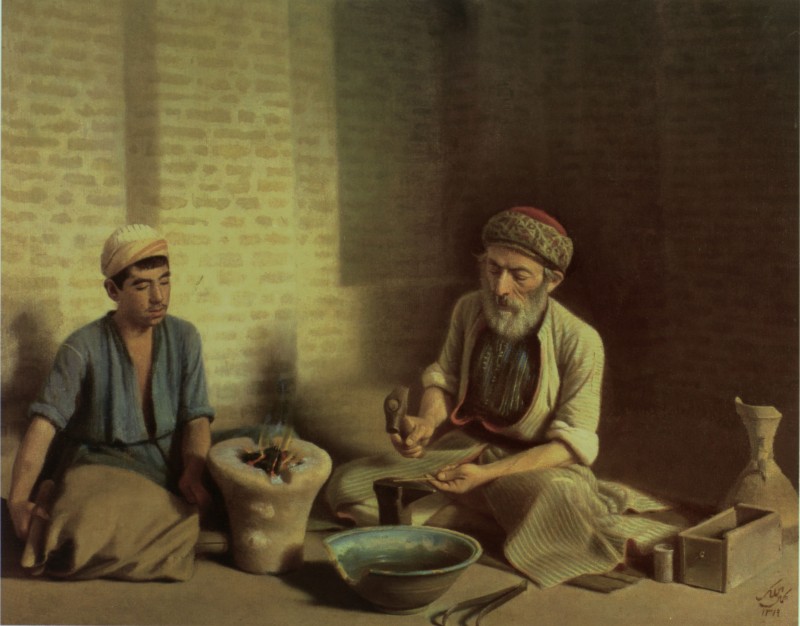|
Domenico Ghirlandaio
Domenico di Tommaso Curradi di Doffo Bigordi (2 June 1448 – 11 January 1494), professionally known as Domenico Ghirlandaio (also spelt as Ghirlandajo), was an Italian Renaissance painter born in Florence. Ghirlandaio was part of the so-called "third generation" of the Florentine Renaissance, along with Verrocchio, the Pollaiolo brothers and Sandro Botticelli. Ghirlandaio led a large and efficient workshop that included his brothers Davide Ghirlandaio and Benedetto Ghirlandaio, his brother-in-law Bastiano Mainardi from San Gimignano, and later his son Ridolfo Ghirlandaio. Many apprentices passed through Ghirlandaio's workshop, including Michelangelo. His particular talent lay in his ability to posit depictions of contemporary life and portraits of contemporary people within the context of religious narratives, bringing him great popularity and many large commissions.Toman, Rolf Life and works Early years Ghirlandaio was born Domenico di Tommaso di Currado di D ... [...More Info...] [...Related Items...] OR: [Wikipedia] [Google] [Baidu] |
Self-portrait
Self-portraits are Portrait painting, portraits artists make of themselves. Although self-portraits have been made since the earliest times, the practice of self-portraiture only gaining momentum in the Early Renaissance in the mid-15th century that artists can be frequently identified depicting themselves as either the main subject, or as important characters in their work. With better and cheaper mirrors, and the advent of the panel painting, panel portrait, many painters, sculptors and printmakers tried some form of self-portraiture. ''Portrait of a Man in a Turban'' by Jan van Eyck of 1433 may well be the earliest known panel self-portrait. He painted a separate portrait of his wife, and he belonged to the social group that had begun to commission portraits, already more common among wealthy Netherlanders than south of the Alps. The genre is venerable, but not until the Renaissance, with increased wealth and interest in the individual as a subject, did it become truly popular. ... [...More Info...] [...Related Items...] OR: [Wikipedia] [Google] [Baidu] |
Sandro Botticelli
Alessandro di Mariano di Vanni Filipepi ( – May 17, 1510), better known as Sandro Botticelli ( ; ) or simply known as Botticelli, was an Italian painter of the Early Renaissance. Botticelli's posthumous reputation suffered until the late 19th century, when he was rediscovered by the Pre-Raphaelites who stimulated a reappraisal of his work. Since then, his paintings have been seen to represent the linear grace of late Italian Gothic and some Early Renaissance painting, even though they date from the latter half of the Italian Renaissance period. In addition to the mythological subjects for which he is best known today, Botticelli painted a wide range of religious subjects (including dozens of renditions of the ''Madonna and Child'', many in the round tondo shape) and also some portraits. His best-known works are '' The Birth of Venus'' and '' Primavera'', both in the Uffizi in Florence, which holds many of Botticelli's works.. Botticelli lived all his life in the same neig ... [...More Info...] [...Related Items...] OR: [Wikipedia] [Google] [Baidu] |
Andrea Del Verrocchio
Andrea del Verrocchio ( , , ; born Andrea di Michele di Francesco de' Cioni; – 1488) was an Italian sculpture, sculptor, List of Italian painters, painter and goldsmith who was a master of an important workshop in Florence. He apparently became known as ''Verrocchio'' after the surname of his master, a goldsmith. Few paintings are attributed to him with certainty, but important painters were trained at his workshop. His pupils included Leonardo da Vinci, Pietro Perugino and Lorenzo di Credi. His greatest importance was as a sculptor and his last work, the Equestrian statue of Bartolomeo Colleoni in Venice, is generally accepted as his masterpiece. Life Verrocchio was born in Florence in around 1435. His father, Michele di Francesco Cioni, initially worked as a tile and brick maker, then later as a tax collector. Verrocchio never married, and had to provide financial support for some members of his family. He was at first apprenticed to a goldsmith. It has been suggested that ... [...More Info...] [...Related Items...] OR: [Wikipedia] [Google] [Baidu] |
Mosaic
A mosaic () is a pattern or image made of small regular or irregular pieces of colored stone, glass or ceramic, held in place by plaster/Mortar (masonry), mortar, and covering a surface. Mosaics are often used as floor and wall decoration, and were particularly popular in the Ancient Rome, Ancient Roman world. Mosaic today includes not just murals and pavements, but also artwork, hobby crafts, and industrial and construction forms. Mosaics have a long history, starting in Mesopotamia in the 3rd millennium BC. Pebble mosaics were made in Tiryns in Mycenean civilisation, Mycenean Greece; mosaics with patterns and pictures became widespread in classical times, both in Ancient Greece and Ancient Rome. Early Christian basilicas from the 4th century onwards were decorated with wall and ceiling mosaics. Mosaic art flourished in the Byzantine Empire from the 6th to the 15th centuries; that tradition was adopted by the Norman dynasty, Norman Kingdom of Sicily in the 12th century, by th ... [...More Info...] [...Related Items...] OR: [Wikipedia] [Google] [Baidu] |
Alesso Baldovinetti
Alesso or Alessio Baldovinetti (14 October 1427 – 29 August 1499) was an Italian early Renaissance painter and draftsman. Biography Baldovinetti was born in Florence to a rich noble family of merchants. In 1448 he was registered as a member of the Guild of St. Luke: "Alesso di Baldovinetti, dipintore." He was a follower of the group of scientific realists and naturalists in art which included Andrea del Castagno, Paolo Uccello and Domenico Veneziano. Tradition says that he assisted in the decorations of the church of S. Egidio, however no records confirm this. These decoration were carried out during the years 1441–1451 by Domenico Veneziano and in conjunction with Andrea del Castagno. That he was commissioned to complete the series at a later date (1460) is certain. In 1460 Alesso was employed to paint the great fresco of the'' Annunciation'' in the cloister of the Basilica della Santissima Annunziata di Firenze, Annunziata basilica. The remains as we see them give evidence ... [...More Info...] [...Related Items...] OR: [Wikipedia] [Google] [Baidu] |
Garland
A garland is a decorative braid, knot or wreath of flowers, leaves, or other material. Garlands can be worn on the head or around the neck, hung on an inanimate object, or laid in a place of cultural or religious importance. In contemporary times, Garlands are used to decorate, especially around holidays Etymology From the French language, French , itself from the Italian language, Italian , a braid. Types *Bead garland *Flower garland **Lei (garland), Lei – The traditional garland of Hawaiʻi. **Daisy chain – A garland created from the Bellis, daisy flower (generally as a children's game) is called a daisy chain. One method of creating a daisy chain is to pick daisies and create a hole towards the base of the stem (such as with fingernails or by tying a Overhand knot, knot). The stem of the next flower can be threaded through until stopped by the head of the flower. By repeating this with many daisies, it is possible to build up long chains and to form them into simple bra ... [...More Info...] [...Related Items...] OR: [Wikipedia] [Google] [Baidu] |
Goldsmith
A goldsmith is a Metalworking, metalworker who specializes in working with gold and other precious metals. Modern goldsmiths mainly specialize in jewelry-making but historically, they have also made cutlery, silverware, platter (dishware), platters, goblets, decorative and serviceable utensils, and ceremonial or religious items. Goldsmiths must be skilled in forming metal through file (tool), filing, brazing, soldering, sawing, forging, Casting (metalworking), casting, and polishing. The trade has very often included jewelry-making skills, as well as the very similar skills of the silversmith. Traditionally, these skills had been passed along through apprenticeships; more recently jewelry arts schools, specializing in teaching goldsmithing and a multitude of skills falling under the jewelry arts umbrella, are available. Many universities and junior colleges also offer goldsmithing, silversmithing, and metal arts fabrication as a part of their fine arts curriculum. Gold Compar ... [...More Info...] [...Related Items...] OR: [Wikipedia] [Google] [Baidu] |
Giorgio Vasari
Giorgio Vasari (30 July 1511 – 27 June 1574) was an Italian Renaissance painter, architect, art historian, and biographer who is best known for his work ''Lives of the Most Excellent Painters, Sculptors, and Architects'', considered the ideological foundation of Western art history, art-historical writing, and still much cited in modern biographies of the many Italian Renaissance artists he covers, including Leonardo da Vinci and Michelangelo, although he is now regarded as including many factual errors, especially when covering artists from before he was born. Vasari was a Mannerist painter who was highly regarded both as a painter and architect in his day but rather less so in later centuries. He was effectively what would now be called the minister of culture to the Medici court in Florence, and the ''Lives'' promoted, with enduring success, the idea of Florentine superiority in the visual arts. Vasari designed the ''Tomb of Michelangelo'', his hero, in the Santa Croce, Fl ... [...More Info...] [...Related Items...] OR: [Wikipedia] [Google] [Baidu] |
Michelangelo
Michelangelo di Lodovico Buonarroti Simoni (6March 147518February 1564), known mononymously as Michelangelo, was an Italian sculptor, painter, architect, and poet of the High Renaissance. Born in the Republic of Florence, his work was inspired by models from classical antiquity and had a lasting influence on Western art. Michelangelo's creative abilities and mastery in a range of artistic arenas define him as an archetypal Renaissance man, along with his rival and elder contemporary, Leonardo da Vinci. Given the sheer volume of surviving correspondence, sketches, and reminiscences, Michelangelo is one of the best-documented artists of the 16th century. He was lauded by contemporary biographers as the most accomplished artist of his era. Michelangelo achieved fame early. Two of his best-known works, the ''Pietà (Michelangelo), Pietà'' and ''David (Michelangelo), David'', were sculpted before the age of 30. Although he did not consider himself a painter, Michelangelo created ... [...More Info...] [...Related Items...] OR: [Wikipedia] [Google] [Baidu] |
Ridolfo Ghirlandaio
Ridolfo di Domenico Bigordi, better known as Ridolfo Ghirlandaio (14 February 1483 – 6 June 1561) was an Italian Renaissance painter active mainly in Florence. He was the son of Domenico Ghirlandaio. Biography He was born in Florence. Since he was eleven years old when his father died, Ridolfo was brought up by his uncle Davide Ghirlandaio, also a painter. Vasari states that he received further training under Fra Bartolomeo. His works painted between 1504 and 1508 show a marked influence from Fra Bartolomeo and Raphael, with whom he was friends. Raphael asked Ridolfo to join him in Rome in 1508, but the Florentine painter stayed. In Florence, he became one of the most prominent painters of altarpieces, frescoes, and portraits, many of which survive. He was also the head of a thriving workshop whose pupils included Michele Tosini (also known as Michele di Ridolfo), Domenico Puligo, Bartolomeo Ghetti, Antonio del Ceraiolo, Toto del Nunziata, Mariano Graziadei da Pescia, Carlo ... [...More Info...] [...Related Items...] OR: [Wikipedia] [Google] [Baidu] |
San Gimignano
San Gimignano (; named after St. Geminianus) is a small walled medieval hill town in the province of Siena, Tuscany, north-central Italy. Known as the Town of Five Towers, San Gimignano is famous for its medieval architecture, unique in the preservation of about a dozen of its tower houses, which, with its hilltop setting and encircling walls, form "an unforgettable skyline". Within the walls, the well-preserved buildings include notable examples of both Romanesque and Gothic architecture, with outstanding examples of secular buildings as well as churches. The Palazzo Comunale, the Collegiata and Church of Sant' Agostino contain frescos, including cycles dating from the 14th and 15th centuries. The "Historic Centre of San Gimignano" is a UNESCO World Heritage Site. The town also is known for saffron, the dry aged and saffron infused ''Golden Ham'', pecorino cheese and its white wine, Vernaccia di San Gimignano, produced from the ancient variety of Vernaccia grape grown o ... [...More Info...] [...Related Items...] OR: [Wikipedia] [Google] [Baidu] |










